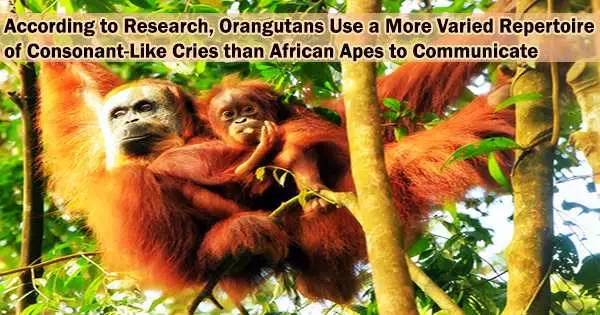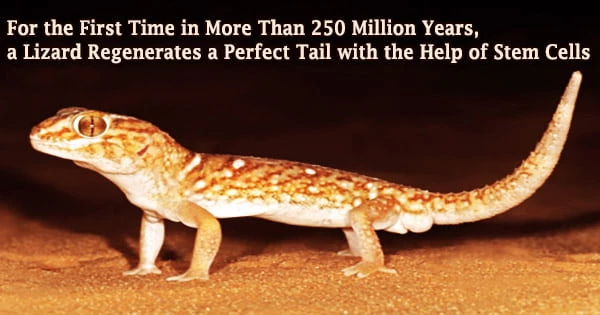The most arboreal of the great apes, orangutans, generate consonant-like noises more frequently and in a wider variety than their African ground-dwelling relatives, according to recent research from The University of Warwick (gorillas, bonobos and chimpanzees).
Contrary to popular belief, African apes don’t have call repertoires that resemble human speech despite being closely related to us. Large and varied inventory of consonant-like cries appear to have emerged from tree-dwelling apes like orangutans rather than the ground-dwelling apes, suggesting that arboreal versus terrestrial lifestyles drove great apes to create divergent vocal repertoires.
According to the study, our own evolutionary ancestors may have spent more time in trees than previously believed.
Dr. Adriano Lameira, Associate Professor of Psychology at The University of Warwick, investigated the origins of human spoken language, which is universally composed of vowels that take the form of voiced sounds, whereas voiceless sounds take the form of consonants.
For decades, researchers have examined non-human primates to learn more about how speech and language developed in our species. However, voiced vowel-like sounds make up the majority or all of the sounds in non-human primates’ calls.
It is because of this limitation, that orangutans have developed greater control over their lips, tongue and jaw and can use their mouths as a fifth hand to hold food and manoeuvre tools. Orangutans are known for peeling an orange with just their lips so their fine oral neuro-motoric control is far superior to that of African apes, and it has evolved to be an integral part of their biology.
Dr. Adriano Lameira
“This raises questions about where all the consonants, that compose all the world’s languages, originally come from,” says Dr. Adriano Lameira.
“Existing theories of speech evolution have thus far, focused exclusively on the connection between primate laryngeal anatomy and human use of vowels. This doesn’t explain though, how voice-less, consonant-like sounds became a fundamental component of every language spoken around the globe.”
Dr. Lameira studied patterns of consonant-like vocal production in the vocal repertoire of three major great ape lineages orangutans, gorillas, bonobos, and chimpanzees to better understand the origins of human speech and the root-cause of consonant sounds in the human lineage.
Great ape call repertoires include both consonant-like and vowel-like cries, unlike those of other primates but like those of any spoken human language. However, there are discrepancies in the way that great apes employ consonants in the wild.
“Wild gorillas, chimpanzees and bonobos don’t use a huge variety of consonant-like calls,” he explains.
Gorillas, for instance, have been observed to make a certain consonant-like call, but only in certain groups of gorillas. In certain chimpanzee communities, a single behavior, like as grooming, is connected with one or two consonant-like noises; however, similar grooming calls are uncommon in other chimpanzee populations.
But unlike humans, wild orangutans make consonant-like cries consistently and universally throughout communities and for a variety of behaviors. They have a diverse vocal range that includes raspberries, clicks, kiss-sounds, splutters, and smacking.
According to Professor Lameira, who has spent the last 18 years studying orangutans in their native habitat, their arboreal lifestyle and food preferences may assist to explain the depth and complexity of their consonant-like cries.
All apes are accomplished extractive foragers. They have evolved sophisticated systems to obtain items that are guarded or concealed, such as nuts or plant piths, which frequently necessitate the careful application of hands or tools.
Orangutans get their food in the canopy, where at least one of their limbs is constantly utilized to give stability between the trees, unlike apes like gorillas and chimpanzees that need the stability of the ground to handle these foods and use tools.
“It is because of this limitation, that orangutans have developed greater control over their lips, tongue and jaw and can use their mouths as a fifth hand to hold food and manoeuvre tools. Orangutans are known for peeling an orange with just their lips so their fine oral neuro-motoric control is far superior to that of African apes, and it has evolved to be an integral part of their biology,” states Dr. Lameira.
According to the research, living in trees may have served as a preadaptation for the development of consonants and, consequently, speaking in our ancestors.
The paper, Arboreal origin of consonants, and thus, ultimately, speech, has been published in Trends in Cognitive Sciences.
















